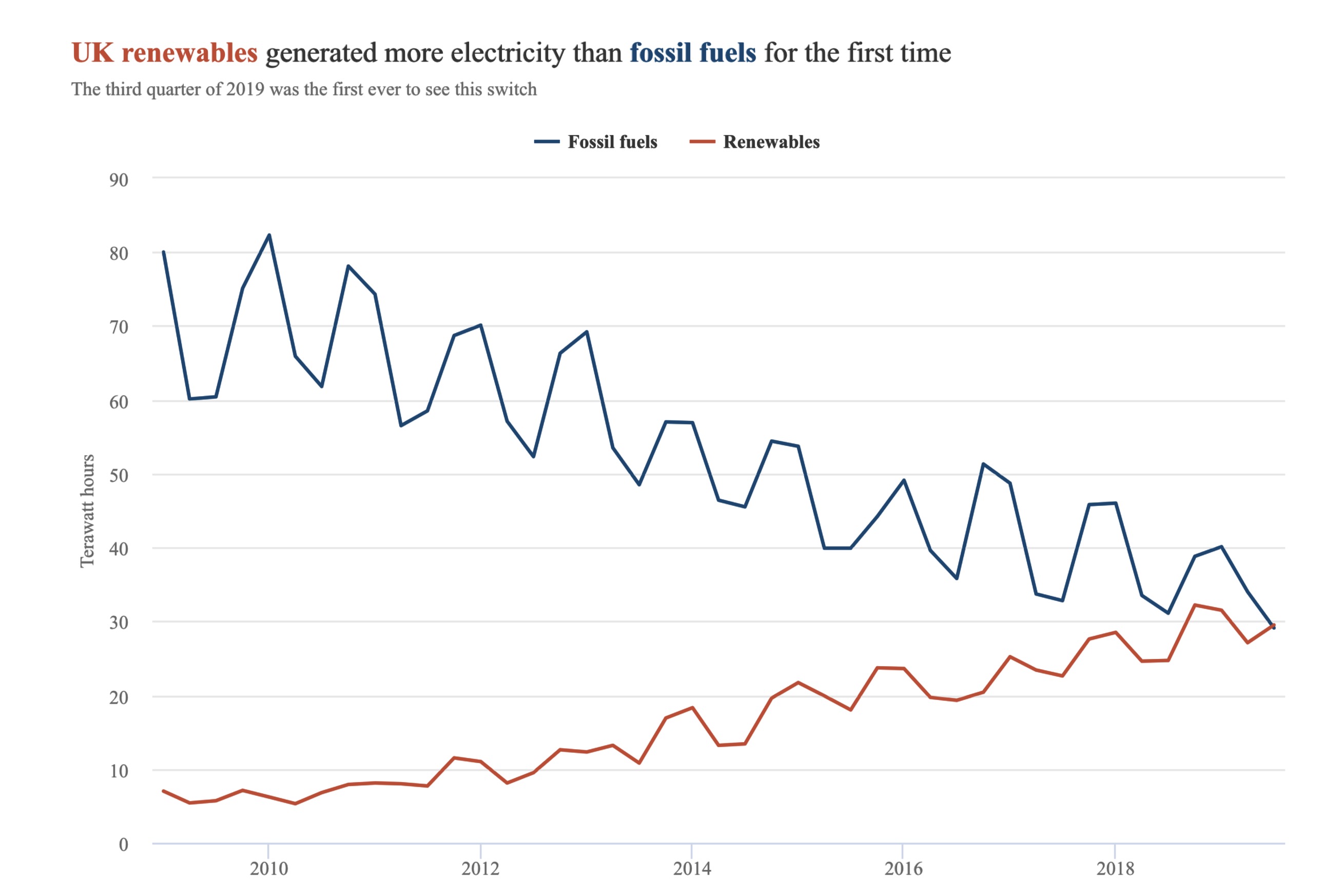
- Sustainable Planet -
- 5mins -
- 224 views
UK Renewable Energy Overtakes Fossil Fuels for the First Time
A decade ago, 10 times more energy came from burning fossil fuels than renewable energy. But now, for the first time, more energy comes from renewables!
Green energy generated more electricity than fossil fuel over last quarter
Renewable energy generated more electricity than fossil fuel power plants over the most recent quarter of this year. In an eco first for the UK, renewable energy — not including nuclear — provided 40% of all of Britain’s electricity needs. Wind farms, solar panels, biomass and hydropower plants generated around 29.5 terawatt hours (TWh) of power. That is higher than the 29.1 TWh for power stations fired by coal, gas and oil. It is the first time renewables have outpaced fossil fuels since the first public power station opened in 1882.

Analysis: United Kingdom’s renewables generate more electricity than fossil fuels for first time
During the three months of July, August and September, renewables generated an estimated total of 29.5 terawatt hours (TWh), compared with just 29.1TWh from fossil fuels, analysis by climate website Carbon Brief shows.
This is the first-ever quarter where renewables outpaced fossil fuels since the UK’s first public electricity generating station opened in 1882. It is another symbolic milestone in the remarkable transformation of the UK’s electricity system over the past decade.
At the start of this decade in 2010, the 288TWh generated from fossil fuels accounted for around three-quarters of the UK total. It was also more than 10 times as much electricity as the 26TWh that came from renewables.
Since then, electricity generation from renewable sources has more than quadrupled – and demand has fallen – leaving fossil fuels with a shrinking share of the total.
However, a lack of progress in other areas of the economy has meant the UK still remains far off track against its upcoming legally-binding carbon targets, let alone the recently adopted goal of net-zero greenhouse gas emissions by 2050.
Source: CarbonBrief
It’s now a question of when—not if—renewables will overtake fossil fuel use for good
Gas now contributes the vast majority of that shrinking total, as coal plants close down ahead of a planned phaseout in 2025. These ageing power stations were mostly built in the 1960s and 70s and are increasingly uneconomic to run due to CO2 prices, market forces and pollution rules.
- In the third quarter of 2019, some 39% of UK electricity generation was from coal, oil and gas, including 38% from gas and less than 1% from coal and oil combined.
- Another 40% came from renewables, including 20% from wind, 12% from biomass and 6% from solar. Nuclear contributed most of the remainder, generating 19% of the total.
While Carbon Brief think it is unlikely that renewables will generate more electricity than fossil fuels during the full year of 2019, it is now a question of when – rather than if – this further milestone will be passed.
This summer, the National Grid predicted that zero-carbon sources of electricity – wind, nuclear, solar and hydro, but not biomass – would generate more electricity than fossil fuels during 2019. Carbon Brief’s analysis through to the third quarter of the year is in line with this forecast.
Source: CarbonBrief

New capacity to generate renewable power is a significant reason for shift
The most significant reason for rising renewable generation has been an increase in capacity as new offshore windfarms have opened.
The 1,200 megawatt (MW) Hornsea One project was completed in October, becoming the world’s largest offshore windfarm. The 588MW Beatrice offshore wind farm was completed in Q2 of this year.
These schemes add to the more than 2,100MW of offshore capacity that started operating during 2018. Further capacity is already being built, including the 714MW East Anglia One project that started generating electricity this year and will be completed in 2020.
In total, government contracts for offshore wind will take capacity from nearly 8,500MW today to around 20,000MW by the mid-2020s. The government and industry are jointly aiming for at least 30,000MW of offshore wind capacity by 2030, with two further contract auctions already expected.
In terms of fossil-fuel generating capacity, the UK’s remaining coal plants are rapidly closing down, well ahead of a 2025 deadline to phase out unabated burning of the fuel. By March 2020, just four coal plants will remain in the UK.
Carbon Brief’s electricity-sector analysis shows that renewables are also estimated to have generated more electricity than fossil fuels during the individual months of August and September, the first time there have been two consecutive such months.
Previously, renewables beat fossil fuels in September 2018 – the first-ever whole month – and then again in March 2019. This means that there have only ever been four months where renewables outpaced fossil generation, of which three have been this year and two in the last two months.
In the first three quarters of 2019, renewables outpaced fossil fuels on 103 of the 273 individual days, Carbon Brief analysis suggests. This is more than one-third of the days in the year so far and includes 40 of the 91 days in the third quarter of 2019.
(Although this is not a majority of days, the aggregate output during the quarter was higher for renewables. This is because their excess over fossil fuels was large on some days.)
There have already been nearly as many higher renewable days in the first three quarters of 2019, at 103, as there were in the whole of 2018, which saw 107 such days.
There were only 58 such days in 2017, just 16 in 2016 and 12 in 2015. The first ever day when UK renewables generated more electricity than fossil fuels was 11 April 2015.
Source: CarbonBrief

